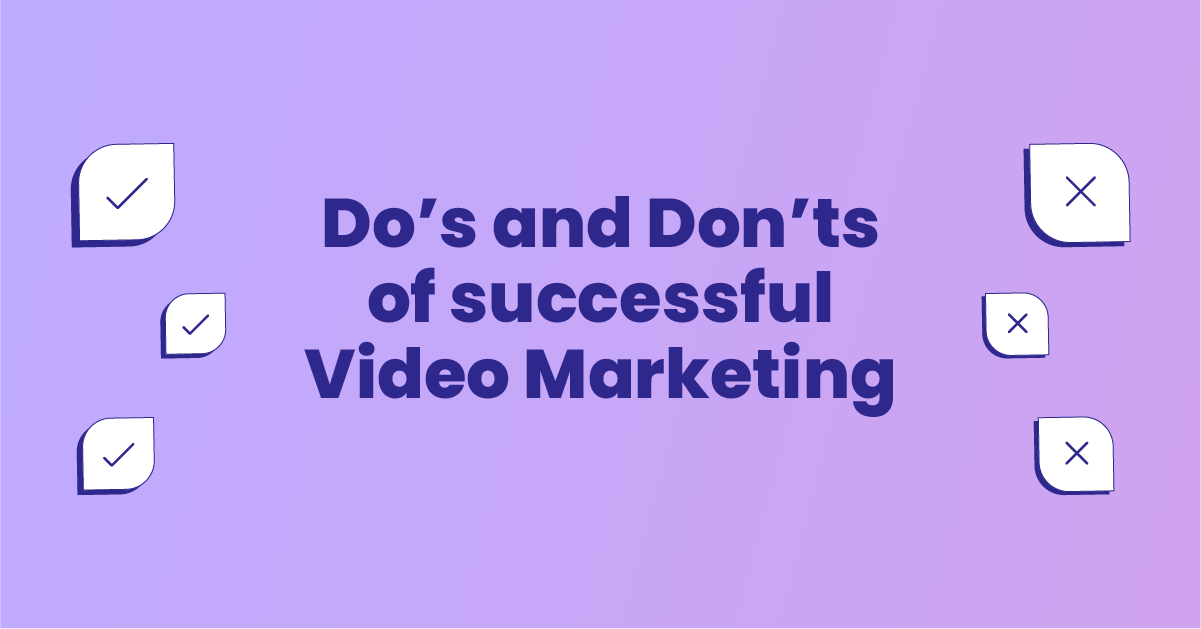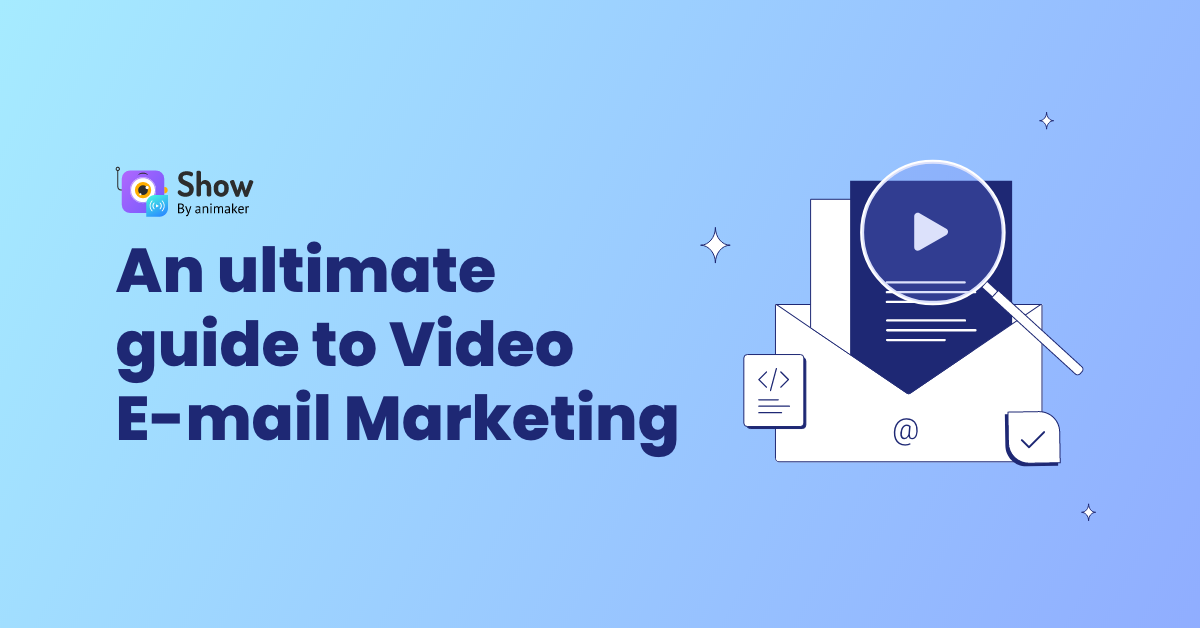Contents
Why should you focus on video marketing today?
Examples of brilliant video marketing campaigns:
Do’s and Don’ts for your video marketing campaigns to be successful:
28 Video Marketing Dos and Don'ts You Should Know in 2021
“They cut through the noise.”
Thankfully, video marketing does exactly that for brands of all sizes and shapes. How else could a simple video made in 2012 by The Dollar Shave Club go super-viral? We will talk about it a bit more in this article.
Integrating videos into your marketing campaigns is called video marketing. There has been a great deal of buzz in this area, thanks to a drastic rise in video consumption. 97% of marketers are of the opinion that videos have helped their users gain a greater understanding of their products and services. The pandemic has also contributed to the increase in video consumption.
Why should you focus on video marketing today?
For top-of-the-funnel prospects, videos are one of the most effective techniques to spread the word about your brand. Let us look at a few reasons as to why you should focus on video marketing to achieve your business objectives.
1. It helps your prospective customers understand more about your brand. Videos can be presented in an easily consumable manner.
2. Most of the videos available are played on mobile devices. There is a rapid increase in the number of mobile users and videos are going to be at the top of the table as a preferred marketing channel.
3. Video marketing provides great ROI. All you need to do is prepare a video that effectively describes your product and you are already better off than most of your competitors.
4. You can leverage videos to build a trusting relationship between you and your customers.
5. Videos are great at driving engagements on social media. Even on an image-sharing platform like Instagram, video ads receive thrice the engagement than photos.
Examples of brilliant video marketing campaigns:
#1 The Dollar Shaving Club:
It is easily one of the most charming brand videos ever. The video tells you everything you need to know about the product, and it is being told in a wacky manner by the then-CEO himself. Thanks to the video going viral, their servers crashed, unable to bear the load of the traffic, and it took more than 24 hours for the website to be up and running again.
Video: https://www.youtube.com/watch?v=ZUG9qYTJMsI
#2 Coca-Cola:
There are very few brands that are anywhere as good as Coca-Cola when it comes to branding and marketing. Here is a video titled ‘The Last Customer’ which shows a few workers going about their day. Released during the holiday season, the ad reminds the audience that the celebrations and the free time that most of us take for granted is taxing for the workers enabling this.
Video: https://www.youtube.com/watch?v=i-oVg_Ga4Ks
In this ad, Coca-Cola focuses on the importance of being kind to one another. Take a look at the video to understand how the brand tried to create a perception of being humane and generous.
#3 Dove:
The personal care company is one of those rare brands that has got its video strategy always on point. The best one from Dove has got to be its ‘Real Beauty’ ad campaign. The focus of this advertisement was to help women understand that the way they perceive themselves is completely different from how others view them. It will warm your hearts.
Video: https://www.youtube.com/watch?v=XpaOjMXyJGk&t=1s
Do’s and Don’ts for your video marketing campaigns to be successful:
Do’s:
- Define your objectives:
The process of video creation can be a bit complex for those who are not aware of the know-how of it. But the first thing that a business needs to be clear about is what are the objectives that it aims to achieve with video marketing. Without clear direction, your messaging will be wayward and it will reflect in the final product.
- Be clear about your target audience:
Once you are clear about your objectives, the next step is to identify who you want to target. It is imperative that you have a clear idea of your audience based on a variety of characteristics, such as demographic and firmographic information, habits, buying patterns, interests, etc. When your target audience is clearly defined, you will be able to reach them directly instead of having many hits and misses.
- Plan your video content calendar:
Just like having a content calendar for your blogs, it is imperative that you chalk out a plan for your video strategy as well. It is best to have monthly plans laid out with all the stakeholders given access to it. Ensure that you have a variety of video content planned for the month in advance. When you have a video content calendar in place, it becomes easy to prepare them with the right set of resources.
- Use the right video hosting platforms:
If you are serious about video marketing, it is best to invest in a video hosting platform. A good video hosting platform will come with a bunch of features that will change the way your offering is being marketed. Starting from advanced security features to rich analytics dashboards, video hosting platforms can add the right kind of charm to your videos.
Image suggestion- we can add the landing page of Show.
- Keep it short:
There is no appropriate length for a video, that depends on the channel you are using and the message that you want to convey. You can make a great video with three minutes or even fifteen seconds. Some videos make you want for more while there are ones that you wish to get over soon. Think of your video as something that will make your audience want to click on the CTA button.
- Write an interesting script:
No matter how fancy the tools that you used for the video are, if your script is insipid, then nothing else is of consequence. The dialogues should sound natural. Write like how you speak. Structure the story in a sequential manner so that it holds logic in the eyes of the viewer.
- Have a strong CTA:
A small addition that has powerful results is the addition of the simple Call-To-Action button. If your viewer leaves the video without taking any action, it will not help your brand. By showing them the video, you have made a connection. You need to capitalize on this by making them visit a landing page that could tell them more about your business, like a consultation, or make them watch another video that will bring them deeper into the funnel. The intent of a CTA is usually to capture information so that you can increase your conversion rates.
Image source: Show by Animaker
- Invest in video SEO:
If you use the right strategies, you can place your video on top of the search engine results. Assuming that you want to achieve page 1 SERP results, just embedding the YouTube video on your website will not do the trick. You need to invest time and effort in video SEO. Everything from your title, tags, meta tags, video description, features, etc., needs to be in order.
Image suggestion: Show’s backend where we have all the options to add titles, tags, etc.
- Have a strong distribution strategy:
One of the most important tasks when it comes to marketing is distribution. Even if you make the sleekest video ever, your distribution strategy should be on point for it to yield results. Without a distribution plan, there will hardly be any viewers for it. In that case, you will not achieve the numbers you want, and your video marketing campaigns will be a failure.
- Mobile-friendly videos:
Users across the world are 1.5 times more likely to watch your brand’s video using their smartphones. You do not want to create videos that are not compatible with other devices, especially mobile phones. Since people carry smartphones on their person most of the time, video consumption is most likely to happen to them.
- Measure the video’s performance:
After you distribute your video, the job is only half done. You need to measure the ROI of your video content by tracking the numbers. Note down the number of views, time spent on the video, when most of the audience drops off, the number of people who clicked on the CTA, and so on. Each of these metrics has significant value and directly affects your bottom line.
Monitoring the results will give you a clear picture of what your audience prefers, and what they don’t like, and it will provide you insights on what can be done the next time. Metrics such as View Through Rate (VTR), Watch Time, Click Through Rate (CTR), Lifetime Value of Video (LTVV), etc., can be measured on a regular basis.
- Demonstrate how to use your product/services:
Show your customers how they can use your products and services, what they will benefit from buying from you, and what are the different use cases for your product. Once they go through your videos, they are more likely to buy from you as they now have an understanding of how your products/services work. Most buyers are apprehensive about making the final buying decision because they do not understand what exactly your product can or cannot do.
- Be authentic & transparent:
For a brand to flourish, they need to be authentic and transparent. While there are limitations to which some private businesses can be transparent, you can still come across as reliable by showing the values that your brand espouses. Every response or action of yours, starting from how you treat a new customer to how you handle refund requests will speak a lot about you.
- Promote success stories:
Your target audience needs to be sure of what you offer to them. They want to make sure that they are buying from a business which is worth trusting. One of the best ways to make people trust your offering is to show them success stories or testimonials of other customers who are of a similar kind. There is nothing better than a video testimonial that comes straight from the mouth of your customers.
- Leverage user-generated content:
There is no content-type greater than UGC as they come directly from your customers. Your target audience, on seeing user-generated content, will be able to trust you more. It will certainly help in increasing conversions.
Image source: Taggbox
Don’ts:
- Don’t use a lengthy intro:
The audience wants in on the action as soon as the video starts. If you have a long intro before the actual video starts, it will certainly have a lot of drop-offs. The goal is to keep the audience as engaged as possible, a lengthy intro will do the opposite. Try to get done with the intro within less than 5-10 seconds. Even a 10-second long intro is an overkill if you ask us.
- Do not overly self-promote:
Another rookie mistake that most brands commit is to brazenly self-promote the brand on the video. Do not keep talking about the company alone, make sure that there is a storyline. Show the values that your business holds and why your customers should trust in what you offer. Your video content should be share-worthy, and if you only keep harping on about how good your company is, your audience will not share.
- Don’t aim for virality:
The success of a video doesn’t lie in it going viral. If you have a super-specific niche, and let’s say your video has been viewed 10 million times, it will not necessarily help you. Your brand name might get a fillip, but does it help you with conversions? Not necessarily. A better approach would be to tailor your campaign according to your specific goals.
Image source: Shareprogress
- Don’t ape your competitors:
While a bit of competitor research is fine, going out of your way to copy your competitor’s video strategy is an exercise that will only result in embarrassment. Your competitor’s video strategy is specific to their business requirements. Even if you have a similar kind of offering, your audience might be different. Perceptions can be different. Expectations could be completely different. Also, you do not want your target audience to call you out for copying your competitor’s strategy.
- Don’t overlook the aesthetic value of videos:
If your budget doesn’t allow you to go for creative assistance, that doesn’t mean you should ignore aesthetics. Do remember that there is a lot at stake, a shoddy presentation can do more harm to your brand than you can imagine. The quality of your video is something that you cannot afford to compromise on.
- Don’t forget branding:
Make sure you use all your brand identity elements in your videos. Even if they are encountering your brand for the first time by watching your video, they are more likely to remember your business if you don’t forget to brand yourself in it. Your logo, typography, style, theme, shape, form, and other visual elements will lend credibility to your video.
Image source: Spellbrand
- Don’t digress:
The problem with a 2-3 minute video is that you think there is a lot of space to add a bunch of things to it. Wrong. Never do that. It can get confusing for the viewer if they find the trajectory of the video changing constantly. Ensure that your video is clear and simple to consume.
- Don’t forget about your video’s thumbnail:
A video’s thumbnail is the first thing that your viewers are going to see before they click on it. More often than not, the thumbnail is one aspect of the video which prompts people to click on it. You cannot afford to add a shoddy thumbnail to your video. Find out the most interesting aspect of the video and use that as your thumbnail.
Image source: Campaigndonut
- Don’t forget about the visuals:
Using the right visuals can be the difference between a great video and a mediocre one. If you choose visual imagery that doesn’t connect with your audience, your engagement will be low. You need to know what kind of visuals your customers usually prefer. Choose visuals that are in line with what someone expects from your niche.
- Don’t make the storyline too complex:
Your audience might be learned scholars, but that shouldn’t have a bearing on the storyline. Keep the storyline in the video as simple as possible. Your audience wants you to get to the point immediately without having to wait for long. The storyline can be simple and still be incredibly effective.
- Don’t expect overnight results:
One of the best things about videos is that they can lead to virality for your brand. But if that’s your expectation every time you create a video, then your priorities are misplaced. You cannot expect every video to be a hit. Some of them should be taken as a lesson, and use to analyze what went wrong and what could have been made better.
- Don’t focus on sales alone:
If your objective is to sell, then videos are great for that purpose. But if you try to sell like an insurance salesperson, it can get too much for your viewers. In this time and age, you are better off being subtle with your sales techniques. It is a big no-no to go all out on sales in your videos.
- Don’t assume your viewers will watch with audio:
Most of us watch videos without audio. Odd as it may sound, that’s the truth. When you make videos, ensure that the video’s message doesn’t get diluted without audio. While it might not be practically possible everywhere, you can add subtitles to ensure that the viewer isn’t missing out on the conversation. By doing so, you can increase your video engagement rates by 0.18 to 0.39%.
Image source: Android Police
Conclusion:
Video marketing is quintessential for the success of your campaigns, no matter what kind of objectives you have. If you can get the right strategy, you will keep getting the results that you are looking for. Videos have gained tremendous traction of late, and it is high time that you jump onto the bandwagon of video marketing if you already have not.
If you are looking to use the services of a video hosting platform, check out Show by Animaker. Let us know your requirements and we will be delighted to get you started.



